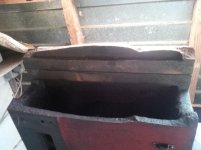Hi, Sorry if this is in the wrong forum, it seemed the most apropriate.
I have unearthed another old belt drive lathe (15x63), no markings or brand, and it's in pieces.
Sorry also, no photos yet, so please bear with my 1000 words.
My query is that the headstock front way has snapped off.
In section it would be a "T" shape with the top being 40mm (1.5") thick and the stem only 15mm (5/8")
For repair my thinking would be to thoroughly clean and degrease the faces of the crack and surrounds, clamp in place and drill/counterbore pins, or even cap screws, through the ways into the bed, however there isn't much "meat" if I went with 10-12mm (3/8-1/2") screws: that's only a couple of mm (16ths) either side, of (presumably soft) Cast Iron.
I could back this up by dishing it out and arc welding it cold (stitches, well peened, alternating ends). Obviously then it needs to be scraped back into line and level.
Is there anyone with any other ideas, or a standard old-timey fix I don't know about?
I have unearthed another old belt drive lathe (15x63), no markings or brand, and it's in pieces.
Sorry also, no photos yet, so please bear with my 1000 words.
My query is that the headstock front way has snapped off.
In section it would be a "T" shape with the top being 40mm (1.5") thick and the stem only 15mm (5/8")
For repair my thinking would be to thoroughly clean and degrease the faces of the crack and surrounds, clamp in place and drill/counterbore pins, or even cap screws, through the ways into the bed, however there isn't much "meat" if I went with 10-12mm (3/8-1/2") screws: that's only a couple of mm (16ths) either side, of (presumably soft) Cast Iron.
I could back this up by dishing it out and arc welding it cold (stitches, well peened, alternating ends). Obviously then it needs to be scraped back into line and level.
Is there anyone with any other ideas, or a standard old-timey fix I don't know about?




